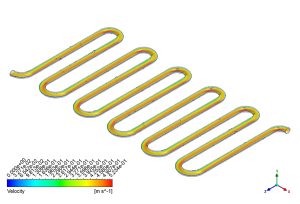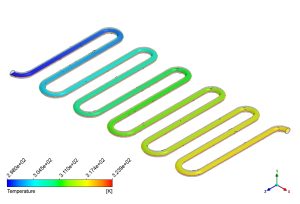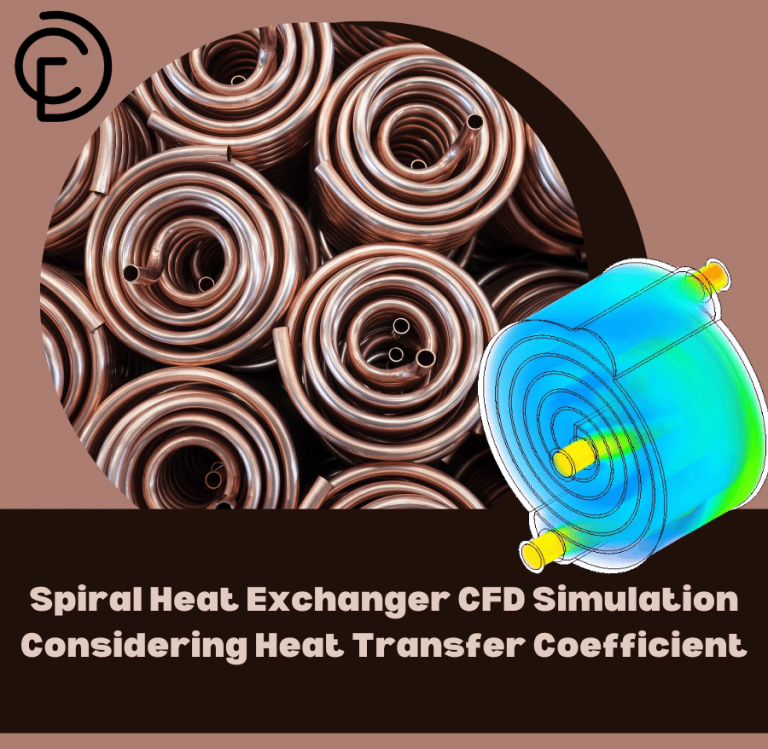Serpentine Heat Exchanger CFD: A Fluent Simulation Tutorial
Serpentine Heat Exchanger CFD: A Fluent Simulation Tutorial
- Upon ordering this product, you will be provided with a geometry file, a mesh file, and an in-depth Training Video that offers a step-by-step training on the simulation process.
- For any more inquiries regarding the product, please do not hesitate to reach out to us at info@CFDLAND.com or through our online support assistant.
€130 Original price was: €130.€65Current price is: €65.
In many modern technologies like HVAC systems and industrial cooling, space is limited, but we still need very effective heating or cooling. The serpentine heat exchanger is a very clever solution to this problem. The design uses a long, winding tube that fits a large surface area into a very small volume. This long path gives the fluid more time and surface to exchange heat, making it very efficient. However, the true benefit comes from the complex flow patterns created inside the curved sections. A Serpentine Heat Exchanger CFD simulation is the best way for engineers to see these patterns and understand how they boost performance. This Heat exchanger CFD analysis is guided by the methods in the reference paper [1] to show how this design works.
- Reference [1]: Awais, M., et al. “Computational assessment of Nano-particulate (Al2O3/Water) utilization for enhancement of heat transfer with varying straight section lengths in a serpentine tube heat exchanger.” Thermal Science and Engineering Progress20 (2020): 100521.

Figure 1- A schematic of a Serpentine Heat Exchanger, the focus of this CFD analysis.
Simulation Process: Modeling the Serpentine Heat Exchanger Fluent Simulation
To begin this Serpentine Fluent simulation, the 3D geometry was first created in Design Modeler. This was done by sweeping a simple circular shape along a winding, serpentine path. Then, using ANSYS Meshing, we created the computational grid. The final mesh contains 115,404 tetrahedral cells, with a special boundary layer mesh near the walls. This fine mesh near the walls is critical for accurately calculating the heat transfer from the tube to the fluid.
Inside ANSYS Fluent, the physics were set up to model the heating process. The energy equation was turned on, and the fluid flowing inside was defined as water. The boundary conditions were set with the water entering the tube at a cool 298 K (25°C). The walls of the entire serpentine tube were kept at a constant hot temperature of 324 K (51°C). This setup allows us to analyze how effectively the hot tube heats the cool water as it flows through.

Figure 2: The geometry and tetrahedral mesh used for the Serpentine Heat Exchanger CFD analysis.
Post-Processing: CFD Analysis – How Curved Pipes Enhance Heat Transfer
The simulation results provide a clear and fully substantiated story that begins with the unique flow inside the curved pipes. When the water flows around a bend, a force called centrifugal force pushes the faster-moving water from the center of the pipe toward the outer wall of the bend. This is clearly shown in the velocity contour in Figure 3, where the highest velocity (~0.923 m/s, shown in red) is not in the middle of the pipe but is shifted toward the outside of each curve. This primary movement creates a secondary flow pattern, known as Dean vortices. These are two small, counter-rotating swirls that travel along the pipe, constantly mixing the fluid. This swirling motion is the true engine of heat transfer enhancement in a Serpentine CFD model.


Figure 3: Velocity and Temperature contours, showing how the curved path creates mixing and enhances heat transfer in the Heat Exchanger Fluent simulation.
This special mixing has a direct and powerful effect on heating the water. In a straight pipe, a cold, slow-moving layer of fluid called the thermal boundary layer forms at the wall, acting like an insulator. The Dean vortices created by the serpentine bends aggressively destroy this insulating layer. They continuously scrape the hot water from the walls and mix it with the colder water in the center. This is proven by the temperature contour in Figure 3. The temperature rises smoothly and steadily along the entire path, from 298 K at the inlet to 318.13 K at the outlet. The most significant achievement of this Serpentine Heat Exchanger Fluent simulation is the clear link it shows between the cause (the centrifugal force creating Dean vortices in the bends) and the effect (the excellent heat transfer and a total temperature rise of 20.13 K). This provides a complete engineering understanding of why serpentine designs are so effective for compact thermal management.
We pride ourselves on presenting unique products at CFDLAND. We stand out for our scientific rigor and validity. Our products are not based on guesswork or theoretical assumptions like many others. Instead, most of our products are validated using experimental or numerical data from valued scientific journals. Even if direct validation isn’t possible, we build our models and assumptions on the latest research, typically using reference articles to approximate reality.
Yes, we’ll be here . If you have trouble loading files, having technical problems, or have any questions about how to use our products, our technical support team is here to help.
You can load geometry and mesh files, as well as case and data files, using any version of ANSYS Fluent.
€160 Original price was: €160.€85Current price is: €85.

€160 Original price was: €160.€75Current price is: €75.

€185 Original price was: €185.€135Current price is: €135.

€120 Original price was: €120.€65Current price is: €65.

€280 Original price was: €280.€145Current price is: €145.

€240 Original price was: €240.€135Current price is: €135.




















Reviews
There are no reviews yet.